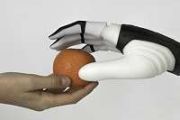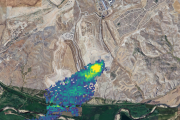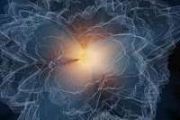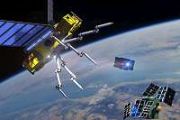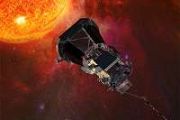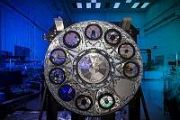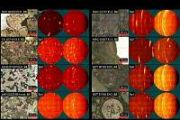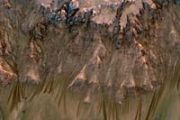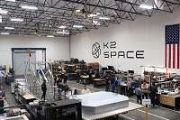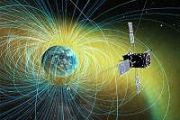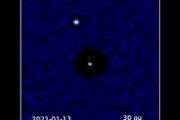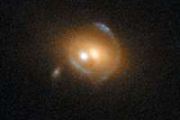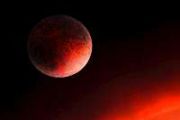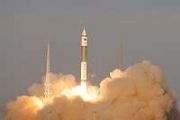
Copernical Team
Baby star blast warps its own disk in rare cosmic feedback loop
 Astronomers in Japan have identified a rare feedback loop in which a young star's explosive outflow has ricocheted back, striking and warping the very disk of gas and dust from which the star formed. The unexpected discovery may force scientists to rethink the conditions under which stars and planetary systems develop.
Stars form when molecular clouds collapse under gravity, spinning into
Astronomers in Japan have identified a rare feedback loop in which a young star's explosive outflow has ricocheted back, striking and warping the very disk of gas and dust from which the star formed. The unexpected discovery may force scientists to rethink the conditions under which stars and planetary systems develop.
Stars form when molecular clouds collapse under gravity, spinning into Paperclip probe could journey to nearby black hole within a century
 It may sound like pure science fiction - a spacecraft no heavier than a paperclip racing toward a black hole at near-light speed - but astrophysicist Cosimo Bambi of Fudan University believes it could be achievable within decades.
Writing in the journal iScience, Bambi presents a conceptual plan for sending a gram-scale nanocraft to a nearby black hole to probe the fabric of space-time and
It may sound like pure science fiction - a spacecraft no heavier than a paperclip racing toward a black hole at near-light speed - but astrophysicist Cosimo Bambi of Fudan University believes it could be achievable within decades.
Writing in the journal iScience, Bambi presents a conceptual plan for sending a gram-scale nanocraft to a nearby black hole to probe the fabric of space-time and Hints emerge of giant planet orbiting Alpha Centauri A
 Astronomers using the NASA ESA CSA James Webb Space Telescope have gathered strong evidence pointing to a giant planet circling Alpha Centauri A, one of the Sun-like stars in the closest stellar system to Earth. Located just 4 light-years away, Alpha Centauri comprises the binary pair Alpha Centauri A and B along with the red dwarf Proxima Centauri, which already hosts three confirmed planets.
Astronomers using the NASA ESA CSA James Webb Space Telescope have gathered strong evidence pointing to a giant planet circling Alpha Centauri A, one of the Sun-like stars in the closest stellar system to Earth. Located just 4 light-years away, Alpha Centauri comprises the binary pair Alpha Centauri A and B along with the red dwarf Proxima Centauri, which already hosts three confirmed planets. Common Mistakes in Video Transcription: How to Avoid Them
 Video transcription is a vital process that allows you to a href="https://any2text.com/video-to-text">convert video to text /a>, making it more accessible and usable for a wide audience. However, it's not always as straightforward as it seems. Even the most experienced transcribers can make mistakes that compromise the quality of the transcription. Understanding common pitfalls and knowing how
Video transcription is a vital process that allows you to a href="https://any2text.com/video-to-text">convert video to text /a>, making it more accessible and usable for a wide audience. However, it's not always as straightforward as it seems. Even the most experienced transcribers can make mistakes that compromise the quality of the transcription. Understanding common pitfalls and knowing how Muon Space launches MuSat XL for advanced LEO missions with Hubble Network as debut customer
 Muon Space has introduced its most capable spacecraft to date, the MuSat XL, a 500 kg-class satellite platform engineered for high-demand low Earth orbit missions. Hubble Network will be the first customer, leveraging the platform for its satellite-powered Bluetooth network.
The MuSat XL extends the flight-proven Halo stack, delivering increased payload capacity, higher power output, and a
Muon Space has introduced its most capable spacecraft to date, the MuSat XL, a 500 kg-class satellite platform engineered for high-demand low Earth orbit missions. Hubble Network will be the first customer, leveraging the platform for its satellite-powered Bluetooth network.
The MuSat XL extends the flight-proven Halo stack, delivering increased payload capacity, higher power output, and a Voyager expands AI radar capabilities with EMSI acquisition
 Voyager Technologies [NYSE: VOYG] has acquired California-based ElectroMagnetic Systems, Inc. (EMSI), a leader in AI-driven automated target recognition and intelligence analytics for space-based radar.
"AI is no longer optional; it's the critical advantage that turns data into dominance, accelerating decision-making and ensuring we outpace and outthink adversaries," said Dylan Taylor, CEO
Voyager Technologies [NYSE: VOYG] has acquired California-based ElectroMagnetic Systems, Inc. (EMSI), a leader in AI-driven automated target recognition and intelligence analytics for space-based radar.
"AI is no longer optional; it's the critical advantage that turns data into dominance, accelerating decision-making and ensuring we outpace and outthink adversaries," said Dylan Taylor, CEO Space-ng launches Sol3 computer vision kit for spacecraft developers
 Space-ng has introduced a rugged, low-cost Hardware Development Kit (HDK) for its space-qualified Sol3 Vision System, alongside a free Software Development Kit (SDK) for evaluation, academic research, and non-commercial use. This open architecture approach aims to make advanced computer vision tools accessible to universities, startups, and aerospace firms.
The Sol3 ecosystem, comprising b
Space-ng has introduced a rugged, low-cost Hardware Development Kit (HDK) for its space-qualified Sol3 Vision System, alongside a free Software Development Kit (SDK) for evaluation, academic research, and non-commercial use. This open architecture approach aims to make advanced computer vision tools accessible to universities, startups, and aerospace firms.
The Sol3 ecosystem, comprising b New internet satellites expand China's orbital network
 China has placed another batch of internet satellites into orbit, marking the third deployment in just over a week. The latest mission, launched Monday evening from the Hainan International Commercial Aerospace Launch Center, carried the seventh group of low-orbit satellites in the national internet network. A Long March 12 rocket lifted off at 6:21 pm and delivered the spacecraft to their plann
China has placed another batch of internet satellites into orbit, marking the third deployment in just over a week. The latest mission, launched Monday evening from the Hainan International Commercial Aerospace Launch Center, carried the seventh group of low-orbit satellites in the national internet network. A Long March 12 rocket lifted off at 6:21 pm and delivered the spacecraft to their plann MetOp-SG-A1 and Sentinel-5 launch highlights
 Video:
00:01:36
Video:
00:01:36
Europe’s first MetOp Second Generation, MetOp-SG-A1, weather satellite – which hosts the Copernicus Sentinel-5 mission – has launched aboard an Ariane 6 rocket from Europe’s Spaceport in French Guiana. The rocket lifted off on 13 August at 02:37 CEST (12 August 21:37 Kourou time).
MetOp-SG-A1 is the first in a series of three successive pairs of satellites. The mission as a whole not only ensures the continued delivery of global observations from polar orbit for weather forecasting and climate analysis for more than 20 years, but also offers enhanced accuracy and resolution compared to the original MetOp mission –
MetOp-SG-A1 and Sentinel-5 launch on Ariane 6
 Video:
00:01:20
Video:
00:01:20
Europe’s first MetOp Second Generation, MetOp-SG-A1, weather satellite – which hosts the Copernicus Sentinel-5 mission – has launched aboard an Ariane 6 rocket from Europe’s Spaceport in French Guiana. The rocket lifted off on 13 August at 02:37 CEST (12 August 21:37 Kourou time).
MetOp-SG-A1 is the first in a series of three successive pairs of satellites. The mission as a whole not only ensures the continued delivery of global observations from polar orbit for weather forecasting and climate analysis for more than 20 years, but also offers enhanced accuracy and resolution compared to the original MetOp mission –









